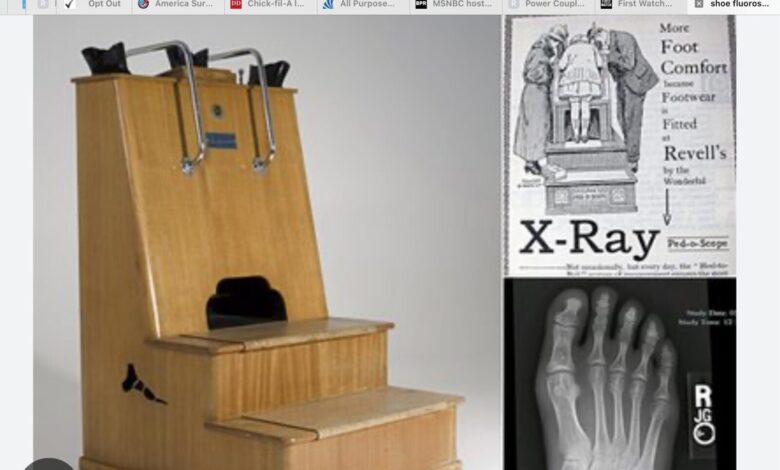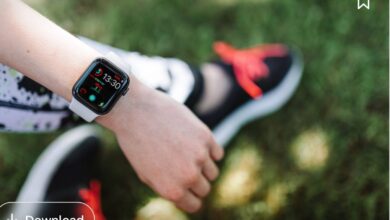SHOE-FITTING FLUOROSCOPES

If you are at least 65 years old, there’s a very good chance you may have used, or been exposed, to the subject of this blog. If your family was financially well-off enough that you wore shoes, and if you bought those shoes at a department store, or shoe store, you probably placed your feet, adorned with the shoes you were considering buying, in a shoe-fitting fluoroscope. These devices commercially called the Foot-O-Scope, Adrian X-ray Shoe Fitter, or Pedoscope were “state of the art” devices used to make sure the shoes you selected for purchase fit properly.
My dad worked at L.S. Ayres Department store in downtown Indianapolis, and because our family received a one-sixth off discount of every item purchased at Ayres, we shopped there exclusively. When my brother and l needed new shoes, Ayres was our only choice. My mother always took us and patiently waited while her two smart-aleck sons tried on pair after pair of the latest style of shoe. Until I was 13 or 14, “trying on” included placing my feet in the x-ray machine to see if the new shoes were the right size.
In the middle of the shoe department sat this upright, brown, wooden box which I thought, minus the knobs and dials, was a large console radio. No, it wasn’t a radio. It was the shoe fluoroscope. Instead of speakers, at the bottom of the front were two slots where you placed your feet with the shoes on. At the top of the “box” were three viewing ports—one for the salesperson, one for my mother, and one for me. Through these ports we all could see the fluoroscopic, or x-ray, image of my feet (at least my bones), in the shoes I was trying on. For a brief twenty seconds, radiation was emitted from an X-ray tube below my feet while a fluoroscope, above my feet, provided negative images of the bones, soft tissues (skin, ligaments, muscle), and shoe outline. This gave a very clear picture if the shoes fit properly.
Though currently banned, from the “mid 1920’s to the 1950’s, these devices sat in the middle of the shoe department, ready when any customer wanted to check the fit of new shoes. I don’t believe the shoe-fitter was left running all the time, but it was turned on and off many times a day by the sales person. Customers received brief, relatively intense, direct radiation aimed toward the feet with a “high degree of scatter found at the foot opening” that distributed itself to the lower body. Store employees, who were neither trained in x-ray technique or knowledgeable of radiation characteristics, operated these devices and unknowingly were repeatedly exposed to secondary radiation.
In 1895, when x-ray was discovered, the adverse affects of radiation were not known. In World War I, fitting machines were developed for the Army and used extensively to be sure soldiers’ shoes/boots fit well. Until after World War II, the effects of radiation were still not known, but the bombing of Hiroshima and Nagasaki gave scientists a clear picture of radiation’s powerful effects. About the same time people began reporting adverse effects of shoe-fitting fluoroscopes. Hand dermatitis, burns on the feet, and damage to growing bones were the concerns of occasional users.
Scientists tried to determine safe levels of radiation exposure, and in so doing discovered shoe-fitting fluoroscopes emitted far greater amounts of radiation than suspected. In 1946, the American Standards Association decided that feet should receive no more than 2 rads per 5-second exposure and children should receive no more than 12 radiation exposures per year. In 1950, a set of guidelines was set for all shoe stores in the country. Over the ensuing years, 60% of all fluoroscope users were found to exceed the exposure guidelines. Levels as high as 75 rads per hour or even 175 rads/hour were detected. Despite high radiation exposure, no injuries et al. were reported. However, one “operator” developed dermatitis of the hands after 10-20 exposures a day for 10 years, and another had serious radiation burns of the leg requiring amputation.
As time went on, and more was learned, individual states began banning these instruments. In 1957, Pennsylvania was the first state to ban shoe fluoroscopy. By 1970, 33 states had outright banned them and 17 others had significant restrictions in place. To my knowledge, in 2025 these instruments are of historical interest only.
“Stray radiation” from these devices was a huge problem. Modern diagnostic and therapeutic exam and treatment rooms are heavily lined with protective materials that block stray exposure to patients and technicians. “A high degree of scatter was found at the foot opening of the machine and fairly high values also were obtained when the instrument was placed beside the foot being examined.” Each of these fluoroscopes was equipped with an automatic switch that shut off exposure after a prescribed period of time—usually 10-30 seconds. Plus the radiation dose could be varied by selecting the “Man,” “Woman,” or “Child” button. The wood was lined by a 1.2 mm sheet of lead except where the viewing ports were located. Little radiation escaped through the viewing ports, but the foot slots were a large source of exposure. Customers could not use the fluoroscope without the sales clerk’s supervision. Nor were long periods of exposure permitted. The devices had those safeguards built in. But “scatter” and random exposure still occurred.
Customers both adult and child were the folks radiation regulators were most concerned about, but sales clerks and store employees received dangerous exposure as well. The customer’s feet were the main targets. Sales people kneeling to help children insert their feet properly received radiation exposure from the foot slots every time they used the machine. The cumulative effects could be serious, but I was unable to find a reference that reported the long term adverse effects of shoe-fitter fluoroscopes.
Needless to say, these devices were like playing with fire. They had the potential to “burn” you badly whenever they were used carelessly. The late 1960’s or early ‘70’s saw the end of shoe-fitter fluoroscopy because experts were concerned about long term effects. I haven’t seen one for a long long time. The shoe business has undergone a strange evolution from meticulously fitting shoes sold by a sales clerk who brought you 6 or 8 boxes with various styles to try. The proper fit was aided by the shoe-fitter fluoroscope. Now, we have outlet malls with no sales clerks, and you try on shoes by picking them from the numerous shelves lining the rows of benches and stools. You try them on, walk a few steps, and decide if they feel right. There’s no sales clerk; only me, my feet, and hundreds of pairs of shoes arranged by size and style.
The retail shoe business was wise to separate itself from theses devices because silently they had been affecting the health of the public, especially, children who unsuspectingly and excitedly saw their bones with this device.
Like cigarette smoking and high fat and high carb diets, shoe-fitting fluoroscopy was found by concerned clinicians and watchdogs to be harming those it sought to help. I do wish I could have found a study of the long term harmful effects of these devices to see if they caused long-term harm. If I do, later, I’ll let you know what I find right away.
References: Dyson ED. Shoe-Fitting X-Ray Fluoroscopes BMJ 1956 Aug 4;2(4987):269-272.
Van Allen WW. Hazards of Shoe-Fitting Fluoroscopes Public Health Rep (1896) 1951 Mar 23;66(12):375-377.
Lewis L, Caplin PE. The Shoe-Fitting Fluoroscope as a Radiation Hazard. California Medicine 1950 Jan;72(1):26-30.
Duffin J, Hayter CR. Baring the sole. The rise and fall of the shoe-fitting fluoroscope. Isis 2000 June:91(2):260-282.





I remember these very well. We used to go to the Marott Shoe Store to buy our shoes and used those X-ray devices all the time. I now know why I’m not 6′ 4″ !!!
Could be!
I remember using these as a kid at the shoe store that was located just north of the Arlington Theater, near 10th and Arlington in Indy. We kids thought this was really neat!
I did, too.